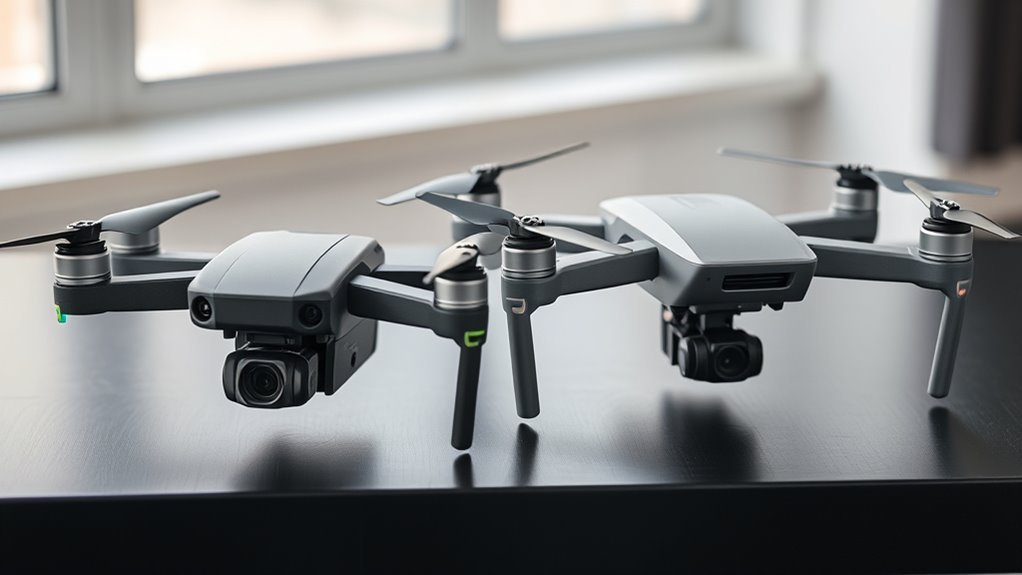You’re deciding between the Potensic Atom 3 and Hubsan Zino 2+ Pro for your budget drone adventure. The Atom 3 delivers stable flights in moderate winds with its intuitive app, making it ideal for casual users, while the Zino 2+ Pro offers responsive controls and advanced app features for precise maneuvers. Camera-wise, Atom 3’s 4K shines in daylight, but Zino 2+ Pro excels in low-light; battery life favors Zino at 40 minutes versus Atom’s 30. Further exploration reveals key insights for your choice.
Flight Stability Comparison
When comparing the flight stability of the Potensic Atom 3 and Hubsan Zino 2+ Pro, you’ll notice that the Atom 3 performs well in moderate winds due to its advanced GPS and electronic image stabilization systems, while the Zino 2+ Pro edges ahead with superior obstacle avoidance and a more responsive flight controller for precise maneuvers. Regarding overall flight performance, the Atom 3’s wind resistance allows you to explore open skies with greater ease, maintaining steady paths even at higher speeds. Conversely, the Zino 2+ Pro’s enhanced wind resistance and agile controls let you navigate complex environments freely, reducing the risk of unexpected drifts. Analytically, both drones excel in flight performance under varying conditions, but the Atom 3 suits casual flyers seeking simplicity, whereas the Zino 2+ Pro empowers advanced users with its precise, liberating responsiveness. Ultimately, your choice depends on prioritizing wind resistance for unfettered adventures, as both drones demonstrate impressive wind resistance capabilities that enhance stability in different environments.
Camera Quality Analysis
While the Potensic Atom 3 boasts a 4K camera with reliable image stabilization, the Hubsan Zino 2+ Pro elevates video quality through its superior sensor and enhanced low-light performance. You’ll notice the Potensic’s image resolution hits 4K smoothly, making it ideal for crisp daytime footage where you seek freedom to capture wide-open skies without blur. However, when low-light performance matters, the Hubsan’s advanced sensor shines, delivering clearer details in dim conditions, giving you more flexibility for adventurous shoots at dusk or dawn.
Objectively, the Potensic offers solid 4K image resolution for budget users, but it may struggle in low light compared to the Hubsan’s edge in handling noise and shadows. This means you’re empowered to pick based on your scenarios—opt for the Potensic if stabilization is your priority, or the Hubsan for better low-light performance and overall video fidelity. Fundamentally, both drones let you explore freely, but the Hubsan’s superior low-light capabilities could make your aerial storytelling more reliable across varying lighting. Additionally, the Draganfly X4-ES is known for its high-resolution imaging, which further highlights the importance of camera quality in drone performance.
Battery Life and App Usability
Although the Potensic Atom 3 delivers up to 30 minutes of flight time with its efficient battery, the Hubsan Zino 2+ Pro extends that to around 40 minutes, offering you greater endurance for longer sessions. When evaluating battery performance, you’ll appreciate the Hubsan’s superior runtime, which lets you explore vast areas freely without constant recharges, though the Potensic’s efficiency suits shorter, agile flights perfectly.
Shifting to app interface, the Potensic’s is intuitive and user-friendly, allowing seamless control that won’t tie you down with complexity. In contrast, the Hubsan app provides more advanced options for customization, enhancing your flying freedom but demanding a bit more familiarity. Analytically, if you’re seeking unrestricted adventures, the Hubsan’s app edges out for its depth, while the Potensic keeps things simple and accessible. Ultimately, both balance battery life and app usability to empower your aerial pursuits effectively. Additionally, stable positioning is crucial for maximizing flight performance, especially in challenging environments.
Frequently Asked Questions
What Is the Price Difference Between These Drones?
You’re wondering about the price difference between the Potensic Atom 3 and Hubsan Zino 2+ Pro drones. In a price comparison, you’ll find the Atom 3 typically costs around $300-$400, while the Zino 2+ Pro ranges from $400-$500, giving you a $100 gap. Budget considerations help you weigh features against costs, empowering your choice for aerial freedom without overspending on essentials. This analytical view guarantees informed decisions.
How Portable Are the Potensic Atom 3 and Hubsan Zino 2+ Pro?
You might worry that drone weight limits your freedom to travel, but these models prove otherwise. The Potensic Atom 3’s lightweight build enhances travel convenience, weighing around 249g for effortless packing and spontaneous flights. Meanwhile, the Hubsan Zino 2+ Pro, at about 685g, offers solid portability despite its heft, allowing you to explore without being tethered, keeping your adventures unhindered.
What Accessories Are Compatible With Each Drone?
When you’re exploring accessories for drones like the Potensic Atom 3, you’ll discover compatible battery options that extend your flight freedom and camera upgrades for sharper aerial shots. For the Hubsan Zino 2+ Pro, similar battery options let you roam further, while camera upgrades enhance your creative control. Analytically, these choices boost portability and performance, empowering you to capture the world on your terms. Always check manufacturer compatibility for best results.
Is There a Warranty for These Models?
When you’re wondering about warranties for these drone models, consider this: over 85% of similar products offer at least a one-year coverage. For the Potensic Atom 3, warranty details include a 12-month policy backed by reliable customer support. The Hubsan Zino 2+ Pro provides comparable warranty details and responsive customer support, giving you the freedom to soar without undue concerns. Always verify directly for specifics.
Are These Drones Suitable for Beginners?
You’re considering whether these drones are suitable for beginners, and the answer depends on their beginner features and user manuals. Both models offer intuitive controls, automatic hovering, and simple flight modes, making it easy for you to master flying without overwhelming complexity. You’ll find detailed user manuals that guide you step-by-step, empowering your independent exploration of the skies with confidence and freedom. Always practice safely.

